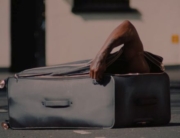
At its core, this inspiring documentary centers on two African American men who share a deep relationship based around their work: 65-year-old Ed “Nardie” White and 30-something Albert Shumake, whom we first meet as they introduce elementary school students in Louisville, Kentucky, to the power of African drumming. White, the co-founder of the River City Drum Corp, or RCDC, has been connecting African American youth to their culture since the early 1990s, while Shumake is one of the organization’s many success stories.
Early on, a montage features photographs and news clippings of the RCDC intercut with present-day high school students, who pledge to work hard and stay out of the trouble in order to be admitted. This glimpse of the group’s storied history is indicative of the fine line directors Marlon Johnson and Anne Flatté walk throughout as they keep one eye fixed on the past.
The camera goes behind the scenes as White and Shumake get the kids to believe in themselves from the get-go through unorthodox self-esteem-building tactics, including building their own drums out of discarded pipe, leather, and other materials. But there is also plenty of footage of the current batch of aspiring young drummers in action, with a drum line of a dozen or more youth. They’re exciting to watch and anchored by affable teens Jailen and Imani, who have moved up in the RCDC to leadership positions as they enter their senior years in high school.
River City Drumbeat mostly takes place in Louisville’s West End, an underserved, largely African American neighborhood that is practically a character in and of itself. The filmmakers linger on boarded-up houses and dilapidated storefronts, and they also utilize overhead shots in which the streets seem to dictate where the camera goes next. White, who grew up here, describes the racist practices that have negatively affected the community, including redlining and threats of violence against those who dared to venture into the white-dominated areas.
Yet the film also reveals the deep-rooted sense of community in the West End, which has the potential to offset a variety of social ills. Beyond visiting the RCDC’s offices, the filmmakers stop into local church services, barber shops, and artists’ studios, where the neighbors look out for one another, especially the youth. White and Shumake are part of one big cycle, paying forward the support they themselves received back when they were coming up.
Something unique that the film addresses is the stereotype that African Americans cannot earn a living through art. Between White, Shumake, Jailen, and Imani (who is a trailblazer in her own right as a female in the male-dominated world of drumming), a shared experience is their choosing the pursuit of art over athletics, which in a sports-dominated city like Louisville could be looked upon as foolhardy. That notion is challenged that by the introduction of artists such as Ed Hamilton, a West End–based sculptor who has done very well for himself, having created several notable works on display around the city.
Curiously, while those profiled include several high schoolers, the conflicts in their lives aren’t particularly dramatic. They already seemed poised for success when we meet them, and while we may keep our fingers crossed that nothing derails them along the way, no potential obstacles materialize. Instead, most of the drama comes from the impending transition in the RCDC’s leadership as White, who has given his all as its director, is finally ready to hang up his drum sticks. He frequently looks weighed down by the past, especially whenever he talks about his late wife, Zambia Nkrumah, whose presence lingers over the film despite her rarely appearing in flashbacks. By contrast, Shumake is full of vigor and excitement, even as he juggles being a new father with his challenging dream job.
Along with being an in-depth study of a vibrant community, River City Drumbeat is highly effective as a snapshot of an organization that has done considerable good for those around it, during a pivotal moment in its history.
















Leave A Comment